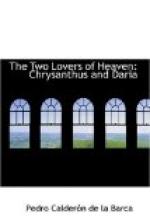Claudius.
Wherefore humbly we entreat
Pardon for our many errors.
3. The whole of the first scene is in ‘asonante’ verse, the vowels being i, e, as in “restrIctEd”, “drIftlEss”, “hIddEn”, etc. These vowels, or their equivalents in sound, will be found pretty accurately represented in the last two syllables of every alternate line throughout the scene, which ends at p. 25, and where the verse changes into the full consonant rhyme.
4. The resemblance between certain parts of Goethe’s Faust and The Wonder-Working Magician of Calderon has been frequently alluded to, and has given rise to a good deal of discussion. In the controversy as to how much the German poet was indebted to the Spanish, I do not recollect any reference to The Two Lovers of Heaven. The following passage, however, both in its spirit and language, presents a singular likeness to the more elaborate discussion of the same difficulty in the text. The scene is in Faustus’s study. Faustus, as in the present play, takes up a volume of the New Testament, and thus proceeds:
“In the beginning was the
word”. Alas!
The first line stops me: how shall I proceed?
“The word” cannot express the meaning
here.
I must translate the passage differently,
If by the spirit I am rightly guided.
Once more,—“In the beginning
was the thought".—
Consider the first line attentively,
Lest hurrying on too fast, you lose the meaning.
Was it then Thought that has created all things?
Can thought make matter? Let us try the line
Once more,—“In the beginning
was the power”—
This will not do—even while I write the
phrase,
I feel its faults—oh! help me, holy Spirit,
I ’ll weigh the passage once again, and write
Boldly,—“In the beginning
was the act”.
Anster’s “Faustus”,
Francfort ed., 1841, p. 63.
5. The same line of argument is worked out with wonderful subtlety of thought and beauty of poetical expression by Calderon, in one of the finest of his Autos Sacramentales, “The Sacred Parnassus”. Autos Sacramentales, tom. vi. p. 10.
6. The metre reverts here again to the asonante form, which is kept up for the remainder of this act. The vowels here used are e, e, or their equivalents.
7. “This Clytie knew, and knew she was
undone,
Whose soul was fix’d,
and doted on the sun”.
Ovid,
Metamorphoses, b. iv.
8. In the whole of this scene the asonante vowels are a-e, or their equivalents.
9. The asonante in e-e, recommences here, and continues until the entry of Chrysanthus.
10. The metre changes to the asonante in a-e for the remainder of this Act.
11. The asonante in this scene is generally in o-e, o-o, o-a, which are nearly all alike in sound. In the second scene the asonante is in a-e, as in “scAttEr”, etc.




